Development is what all BRICS members should be focussing on
By RN Bhaskar and Sakeena Bari Sayyed
Image generated through CoPilot
Ask any economist, and you will be told that to grow meaningfully, countries need to focus on three areas. For economic development they should make focussed investmjents on
- People
- Infrastructure
- Wealth generation – namely business environment
These are the three dwarfs that must be nurtured. They may seem small, but the energies they unleash are immense. China has nurtured the three dwarfs amazingly well. Hence it is important to understand whether India too has been investing enough in the meaningful development of this country we decide to examine several parameters:
- Investment in education as a percentage of GDP
- Investment on business as is evident from GFCF (Gross Fixed Capital Formation) as a percentage of GDP.
- Investment in infrastructure as a percentage of GDP
In order to buttress the people factor with additional data we took two other parameters:
- Literacy rates
- Doctors per 1000 people
Clarifications
Some clarifications required here.
Looking at India alone would have been quite limiting, hence we looked at all the BRICS countries that are officially members of this body. In this connection, there are some important points to note.
First, although Goldman Sachs coined the BRIC acronym in 2001, India just accepted it and did nothing more. It was Russia’s genius that created BRIC as an emerging economies grouping in 2006. It hosted the first annual meeting in 2009, after which South Africa joined in 2010. The five countries were the founding members of BRICS, and other countries given in the tables below join BRICS at different dates.
Second, we chose BRICS because India fancies itself as a leader of this grouping. But leadership also depends on economic strength and vision, not just words. For instance, in the last two years, Iran has been more active in BRICS by persuading other countries to work with BRICS. Hence, we have looked at all the BRICS countries when analyzing the parameters. Without such data one is confronted by claims and to clear the fog an analysis of number becomes critical.
Third, the tables given below are indicative of the importance countries give to these vital parameters.
For instance, investment in people is a very large subject. It includes access to justice (India’s judicial scene is pathetic — there are 50 million cases pending in the pipeline). It also includes providing security, ensuring that each family has a decent house (India slum rehabilitation scheme offer 350 sq. ft as decent housing. Iran offers 900 sq. ft — https://asiaconverge.com/2015/03/762affordable-housing-what-india-can-learn-from-iran/). It also includes factors like sanitation and healthcare (that includes health insurance- https://asiaconverge.com/2018/08/ayushman-bharat-great-concept-doctors-overlooked/). Getting data on all these parameters would have been difficult especially when it comes to other BRICS countries. Hence, we have focused on the data charts given below. Almost all of them have been sourced from the World Bank or Trading Economics, to ensure uniformity and integrity of data sources as well.
Investment in business is not GFCF. It includes an entire business climate. That includes ease of doing business, hassle free environments without the burden of compliances (See table titles More opportunities for graft at- https://asiaconverge.com/2024/05/fantasies-about-indias-economy-might-be-dangerous/). It also includes dispute resolution (https://asiaconverge.com/2020/01/arbitration-and-investment-protection/) and the ability to focus on business instead of constantly changing regulation.
Similarly, infrastructure investment does not capture returns on such investments. It does not consider inflated cost of building infrastructure (time and cost overruns). Nor does it look at the appropriateness of such investments. For instance, India has deferred investments in the Eastern Dedicated Freight Corridor in (DFC) and chose instead to construct expeditiously a less crucial Western DFC (Free subscription — https://bhaskarr.substack.com/p/indias-two-dfcs-politics-trounces). Finally, it does not capture the quality of infrastructure (consider how 12 bridges collapsed within 13 days in Bihar, or the bridge collapses in Gujarat).
Obviously, the datasheets given below offer a partial glimpse and are not exhaustive, but they are good pointers to governance and economic foresight.
The country that ahs done amazing work in education is China. It is perhaps the only country that could eradicate illiteracy within a span of five decades. In spite of that, watch how both Russia and China have witnessed a rise in percentage of GDP for education.
Sadly, the percentage of GDP for education decline for Brazil, India, South Africa, Iran, Indonesia and UAE. Many of BRICS members are developing countries and investments in education should be treated as sacrosanct if not increased. The drop in expenditure as a percentage of GDP underscores a need for these countries to refocus their attention on education. This is more crucial in the coming decade when AI and the changing nature of jobs will require higher levels of literacy and comprehension.
India’s disdain for good education is obvious from its poor focus on internet connectivity, teachers, laboratories and the quality of education provided (Free subscription — https://bhaskarr.substack.com/p/the-state-of-education-in-india). This must change if India has any notions of being a global leader.
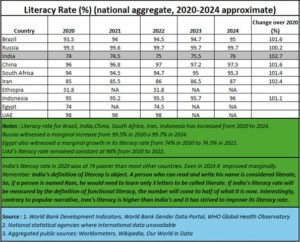 There is a problem even when looking at literacy rates. India’s literacy rates may look reasonable at 74%. But they are lower than the figures for other countries. Moreover, India’s literacy rate should be discounted because of a flawed definition that India adopts for determining literacy. It believes that anyone who can read or write his or her name is literate. So, if a person has a four-letter name and knows just those four alphabets, he is counted among the literate by India’s definition. Given the state of government school education (Free subscription — https://bhaskarr.substack.com/p/the-state-of-education-in-india) India’s literacy rate could be well under 30%. This is terrible. Outcomes need to be measured to ensure quality of education. India refuses to do that.
There is a problem even when looking at literacy rates. India’s literacy rates may look reasonable at 74%. But they are lower than the figures for other countries. Moreover, India’s literacy rate should be discounted because of a flawed definition that India adopts for determining literacy. It believes that anyone who can read or write his or her name is literate. So, if a person has a four-letter name and knows just those four alphabets, he is counted among the literate by India’s definition. Given the state of government school education (Free subscription — https://bhaskarr.substack.com/p/the-state-of-education-in-india) India’s literacy rate could be well under 30%. This is terrible. Outcomes need to be measured to ensure quality of education. India refuses to do that.
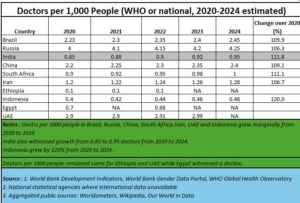 Related to people is healthcare. India’s record from this front is pathetic as has been discussed above. The failure of government bodies even to guide people on what comprises a nutritious meal is frightening (Free subscription — https://bhaskarr.substack.com/p/fssai-and-its-new-nutrition-ratings). Asa result, India loses much of its most productive work force and also burdens them with ailments that were avoidable. Common folk have often to make medical treatment expenses from their own pockets.
Related to people is healthcare. India’s record from this front is pathetic as has been discussed above. The failure of government bodies even to guide people on what comprises a nutritious meal is frightening (Free subscription — https://bhaskarr.substack.com/p/fssai-and-its-new-nutrition-ratings). Asa result, India loses much of its most productive work force and also burdens them with ailments that were avoidable. Common folk have often to make medical treatment expenses from their own pockets.
Without education and health there can be little hope of development.
The only way countries can become more powerful in the world is by encouraging people to generate wealth. For this, governments have to ensure that there is a stable regulatory environment, fewer compliances and freedom from being raided and hauled up by India’s government authorities.
Even if you look at GFCF, India’s numbers must be viewed with caution. India’s investments in industry and business are not always based on economic considerations but are often ideological in nature. Investments on railway lines reaching religious places in less important than improving freight link ages for businesses and industry. Unwise focus on desalination plants conceals India’s inability to even compute and regulate water consumption. If India has to grow more prosperous this parameter needs to be addressed.
By any yardstick China provides one of the best infrastructures in the world. In spite of having the largest number of high-speed trains, it is impressive to see this country investing still in more bullet trains. India’s bullet train is still languishing providing a sharp contrast to China. This is no recipe for development.
Infrastructure is crucial because it provides the platforms on which industry and business can ride. Yet, look at the way the Golden Quadrilateral roadways were built without time and cost overruns. This allowed the Vajpayee government to build infrastructure on which India’s GDP growth climb sharply. Compare the strict time and cost controls for project implementation during that period and contrast them with current cost and time overruns.
Not surprisingly, India’s infrastructure still creaks in most places. Eventually, poor infrastructure results in an additional cost that companies must bear. The philosophy should be that the infrastructure must offer the maximum good to the maximum number of people. Hence, it is strange that even in bustling Mumbai, the Coastal Road which caters to a relatively wealthier group of people collects no tolls, on the contrary the Atal Setu which caters to relatively not- so-affluent people are being asked to pay a huge toll tax. Once again, economic vision which must be dovetailed to social equity is given a go-by in favour of populist schemes.
Conclusion
The above charts show how India’s planners need to be more focussed on development. This means more sensible investments on people welfare and wealth generation than what is being practised currently. Without decent investment in people, business and infrastructure, India could end up as a would-have-been. Its leadership claims could begin to sound hollow.
=================
Do view my latest podcast on how India is witnessing a flight of capital. You can view it at https://www.youtube.com/watch?v=9oxkv8Ub7pw
———————–
And do watch our daily “News Behind the News” podcasts, streamed ‘live’ every morning, Monday through Friday, at 8:15 am IST. The latest can be found at https://www.youtube.com/live/WVmu3G8ujmc?si=1JqHZ-h6D1J7pCG1
============



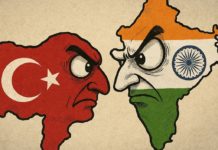








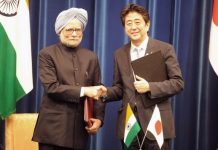








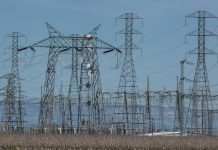




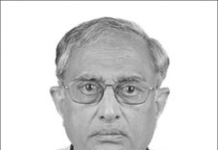



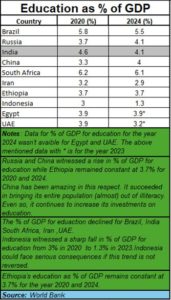
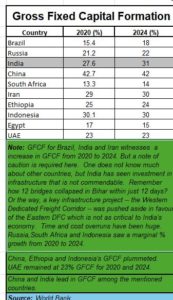
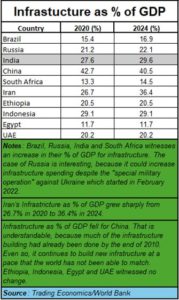






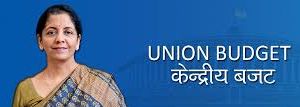
COMMENTS